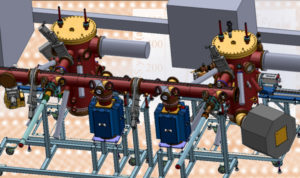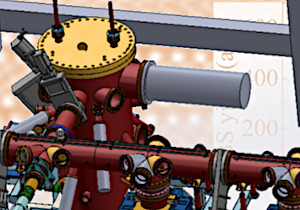
Scientific environnement and working place
The international city of Grenoble is located in the French Alps and surrounded by an exceptional natural environment. It is also an extremely rich ecosystem formed by public research organisations (CEA, CNRS, ESRF, ILL) and the Grenoble Alpes University (UGA), as well as numerous high-tech companies.
The Interdisciplinary Research Institute of Grenoble IRIG belongs with the CEA’s Fundamental Research Department. IRIG develops its activity in the fields of materials science applied to new technologies for energy and the environment, nanosciences, biology and health. The wide range of topics developed at IRIG facilitates the development of excellent multidisciplinary research, supported by outstanding research platforms and infrastructures. Research is generally conducted in the framework of national and international academic partnerships and leads to numerous applications, allowing IRIG to develop industrial partnerships with start-ups, SMEs and large companies.
SPINTEC (SPINtronics and Component Technology) is one of the leading spintronics research laboratories in the world, positioned at the crossroads of science and technology, hosted as one of the 10 IRIG laboratories. SPINTEC is hosted on the MINATEC campus in Grenoble. It was created in 2002 and has grown rapidly to now exceed 100 people, including 47 permanent staff from CEA, CNRS and the University of Grenoble-Alpes. The laboratory aims to create a bridge between fundamental research and applications in spin electronics. As such, the laboratory’s markers are not only scientific publications and communications in international conferences, but also the creation of a consistent patent portfolio and the implementation of relevant functional demonstrators and device nanofabrication. The laboratory has launched four start-ups in the last 12 years. This synergy has placed SPINTEC at the forefront of spintronics research, with a crucial contribution to the emergence in the industry of spintronic memories called MRAM, on which the laboratory holds key patents.
Within SPINTEC, the 2D spintronics research team brings together 4 permanent researchers, plus postdocs, PhD students and trainees. Its research activity relies on the synthesis of new two-dimensional (2D) materials by molecular beam epitaxy, performed in ultra-high vacuum reactors. This class of materials is currently experiencing dramatic interest, because their 2D character provides them with unique properties in electronics, optics, optoelectronics and spintronics. In this context, the team is currently developing an ambitious growth platform consisting of three interconnected epitaxy reactors as well as a set of tools to characterise their structural, electrical and optical properties. This set of instruments has been funded locally by the Auvergne-Rhône-Alpes Region (Minatec Labs 2018 project), by the LABEX initiative LANEF (2D-MAT 2020 project) and the Grenoble initiative IDEX (EPI2D 2017 project), but also nationally by the EQUIPEX+ 2DMAG investment-for-the-future initiative (2021-2027). Spintec’s 2D materials growth platform shall be operated jointly with another laboratory of the IRIG (PHELIQS), and is intended to supply the Grenoble and the national scientific communities with 2D materials and their heterostructures.
Mission
The candidate will be part of SPINTEC’s 2D spintronics team, with the objective of developing and managing the epitaxial growth platform, as well as developing the associated characterisation tools, serving researchers both at the local and the national level.
The mission is twofold :
- The first mission is to ensure the design, implementation and long-term development of a growth platform consisting of three interconnected epitaxy reactors and a set of tools to characterise their structural, electrical and optical properties. This mission will be carried out within the framework of various instrumentation projects, which will be entrusted to the candidate. The work requires close contact with the experimentalists and their collaborators for the implementation of scientific projects, and also for ensuring their technical assistance. The mission of the engineer will be to design the growth and characterisation machines or to upgrade the existing ones, to interface these machines with PCs in order to fully automate the equipment using various links (serial, IEEE, modbus TCP/IP link, etc.) and programming languages (Labview, Python, etc.). This includes the design of mechanical parts and electronic systems to contribute to the instrumental park. This work will evolve over time to meet the needs of the team’s research programmes.
- The second mission is to be responsible for maintaining these facilities in safe and operational conditions. This involves:
- Ensure a regular follow-up through preventive maintenance, and check the proper functioning of the growth chambers and characterisation instruments
- Ensure first level action in case of breakdowns: diagnosis and repair. Be the leading contact with equipment manufacturers for purchases (drafting of specifications), repairs and maintenance.
- Ensure the calibration of experimental devices (optical and electrical benches)
- Manage the stocks of consumables, organise work based on the requests, organise and manage the documentary repository (technical notes, plans).
- Manage all human, technical and financial resources associated with the equipment
- Presenting, distributing and promoting achievements
- Enforce safety rules
- Participate occasionally in certain experiments to optimise interaction with users and the adequacy of maintenance and development with needs.
Requested skills
You have a Master degree (Engineering School Diploma or equivalent), with either broad scope, mechanical or processing focus, followed ideally by 3 to 5 years of professional experience.
Your skills in the following areas will be appreciated: mechanics, CAD, instrumentation and automation, vacuum vessels and technology, thin film growth, more specifically:
- Robust knowledge of engineering techniques and sciences
- Mastery of design and dimensioning
- Automation and computer interfacing to manage a measurement environment, control of measurement and test benches (serial links, IEEE and programming languages).
- Knowledge of industrial drawing and computer-aided design (CAD) for the production of plans using specific software
- Design management: drafting technical and contractual specifications, monitoring implementation with subcontractors, managing modifications, accepting deliverables, lifting reservations
- Knowledge of electronics
Additional skills in one or more of the following areas would be appreciated:
- Vacuum techniques and notions of ultra-high vacuum
- Means of elaboration of thin films (molecular beam epitaxy, sputtering…).
- Language skills (written and oral): French and English (B2 level minimum).
- Your reactivity, organization, team spirit, interpersonal skills, autonomy and your ability to adapt are essential to succeed in this position.
How to apply
Applicants are requested to send a letter of motivation and a detailed CV jointly to Matthieu Jamet and the directors of SPINTEC. The deadline for applications is 31 August 2021. Selected candidates will be informed promptly and invited to a job interview in September 2021. In accordance with the commitments made by the CEA in favour of the integration of people with disabilities, this job is open to all. Additional information: this is a permanent position at the Commissariat à l’énergie atomique et aux énergies alternatives CEA. The initial salary is dependent on experience.

